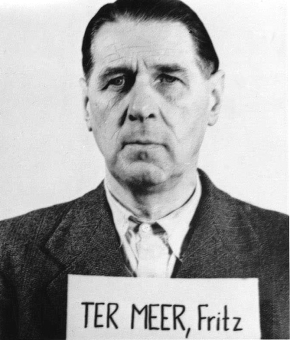Fritz (Friedrich Hermann) ter Meer (1884–1967)

© National Archives, Washington, DC
“For a firm such as the I.G., which exported more than one-fourth of its production to every corner of the world, which maintained numerous business relationships in the countries that now had become enemies, and which was linked with foreign countries by licensing agreements and a broad exchange of experience, the war amounted to the hardest blow that could strike it. Again, as in 1914, all the assets located outside Germany were endangered; again, the worldwide sales organization created over a period of 20 years was to be placed in jeopardy. Nonetheless, to the bitter end, the I.G. did its natural duty for its country as Germany struggled for existence.”[1]
Friedrich (Fritz) Hermann ter Meer was born in Uerdingen on July 4, 1884, the son of chemical industrialist Edmund ter Meer. Fritz ter Meer studied chemistry from 1903 to 1908 in Tübingen, Giessen, Berlin, and Grenoble. For a brief time, he also studied law. In 1909, he received his doctorate in Berlin, with a dissertation “On Our Knowledge of the Ethers of Isonitrosoketones.” Next he devoted himself to the study of the synthetic dye industry in Krefeld and spent several months in England and France. In 1910, he began working at his father’s plant, Chemische Fabriken vorm. Weiler–ter-Meer, in Uerdingen. Fritz ter Meer spent the following three years setting up a branch in France. He was promoted rapidly within the firm, and after holding management positions in the company, he was made a member of the managing board in 1919. He had done no military service and accordingly was not called up during World War I.
After the founding of I.G. Farben, into which Chemische Fabriken vorm. Weiler–ter-Meer 1925 was absorbed, he was a member of the managing board there as well. Fritz ter Meer spent the years 1925 to 1929 predominantly in the United States, where he was involved in helping to set up the plants of the Grasselli Dyestuffs Company, in which the I.G. held shares. Ter Meer was responsible for the I.G.’s negotiations with Standard Oil and was a cofounder of the Joint American Study Corporation (JASCO) in 1929. In 1932, ter Meer became chairman of the Technical Committee (TEA) of I.G. Farben, with responsibility for the technical supervision of all dyeworks in Germany and abroad and for the concern’s strategic technology decisions. He joined the NSDAP in 1937.
Ter Meer represented I.G. Farben in negotiations with the German government, as the result of which natural rubber was taxed on the basis of its difference from the price of synthetic rubber (Buna). In his function as a managing board member and chairman of the TEA, he shared responsibility for the site location and decision-making for the building of the I.G. Farben plant in Auschwitz. Ter Meer was awarded the War Merit Cross 1st and 2nd Class, and was named a “military economy leader” (Wehrwirtschaftsführer).
In September 1943, ter Meer went to Italy as Plenipotentiary for Italy of the Reich Minister for Armaments and War Production. There, in April 1945, he was taken prisoner by the U.S. Army. During the joint imprisonment of the I.G. managing board members in the holding and interrogation center at Kransberg in the Taunus Mountains (codenamed the “Dustbin”), ter Meer organized a common defense strategy for all the defendants. Pressure was applied to those who dissented, particularly to Georg von Schnitzler. In the I.G. Farben Trial at Nuremberg, Fritz ter Meer was sentenced on July 30, 1948, to seven years in prison for “plunder and spoliation” and for “mass murder and enslavement.”
(SP; transl. KL)
















